St. Paul’s Cathedral, located in London, England is the mother church of the Diocese of London, and is the seat of the Bishop of London. This Anglican cathedral was dedicated to Paul the Apostle, founded back in 604AD. The present-day cathedral was designed by Sir Christopher Wren in English Baroque style, after the Great Fire of London. Its world-famous dome, one of the highest in the world, has dominated the skyline for over 300 years and has become an iconic symbol around the world, as well as a representation of national identity.
St. Paul's Cathedral
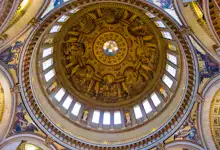
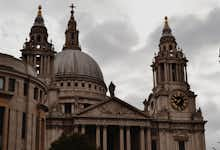
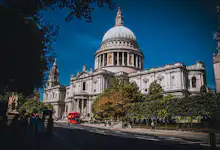
Services held at St Paul's Cathedral London have included jubilee celebrations for Queen Victoria; the funerals of the Duke of Wellington, Sir Winston Churchill, and Baroness Thatcher; peace services marking the end of the First and Second World Wars; the wedding of Prince Charles and Lady Diana Spencer; and the thanksgiving services for the Silver, Golden, and Diamond Jubilees, and the 80th and 90th birthdays of Elizabeth II. St. Paul’s Cathedral London is home to a spectacular array of art; from the delicate carvings of Grinling Gibbons in the quire to Sir James Thornhill's dome murals, as well as the Victorian mosaics and Henry Moore's Mother and Child: Hood.
Hours
8:30 AM - 4:30 PM daily
Address
St. Paul's Churchyard, London EC4M 8AD, UK
Get Directions
Quick Jumplinks to Navigate the Guide
- St. Paul's Cathedral Tickets
- St. Paul's Cathedral Architecture
- Must-see at St. Paul's Cathedral
- Things to See Around St. Paul's Cathedral
- St. Paul's Cathedral - Practical Information
- Insider Tips
St. Paul's Cathedral Tickets
Here is a comparision of the different St. Paul's Cathedral tickets so you can choose the best one for yourself.
St. Paul's Cathedral Architecture

Interior
Designed such that all visitors would be able to see and hear the Mass, the interior is constructed with unobstructed views of the altar and pulpit. It is flooded with natural light from the twenty-four large windows in the dome, as well as the rose windows in the transept. The vaults of the choir, which holds the stalls for the clergy, cathedral officers and the choir, and the organ, are decorated with mosaics by Sir William Blake Richmond. The region by the high altar, though damaged by the Blitz during WW2, was reconstructed with the addition of stained glass. A small chapel here honors American servicemen who lost their lives in WW2.
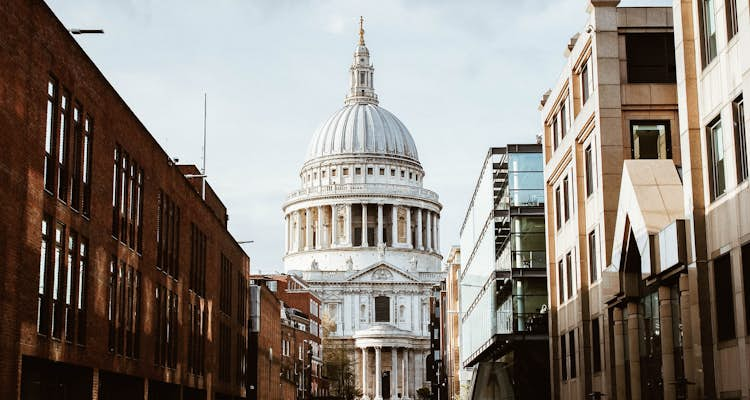
Exterior
Set on Summit Hill overlooking the city of Saint Paul, the architecture of this cathedral is characterized by rounded domes and arches, and a symmetrical floor plan. From the base to the very top of the lantern of the dome, the Cathedral stands 306 feet tall. The church body is made of granite stone, in the shape of a Greek cross with nearly equal length arms. The west front has a figure of Saint Paul himself, flanked by other apostles and the four evangelists. The two western towers are topped with a pineapple - a symbol of peace, prosperity and hospitality. Near the top of the south-west tower is a clock, above which hangs Great Tom, the hour bell, and Great Paul, the largest bell ever cast in the UK. In the Cathedral's north-east churchyard, a plaque marks the location of the St. Paul's Cross, a popular centre of news and comment where Londoners helped to foment public opinion. The column mounted with a gilded statue of St Paul also commemorates the public preaching of the Christian faith in this location.
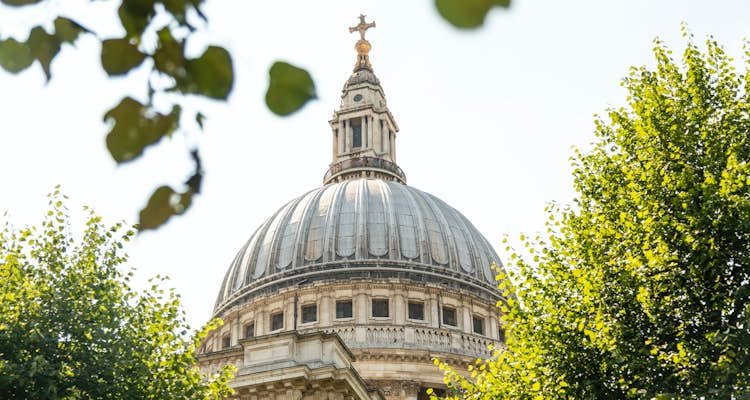
Dome
This St. Paul’s Cathedral dome is the second highest dome in the world at 111m. 60 steps lead visitors along three galleries all the way to the top of the dome. The first gallery inside the dome, the Whispering Gallery, allows whispered communication from any part of the inner dome, to the other. On top of the dome is the narrow Golden Gallery, which encircles the lantern's base. From here you have a magnificent view of London. Scenes from the life of the apostle Paul were painted over the course of four years onto the dome’s ceiling by a man named James Thornhill. However, the paintings on the dome today are actually reproductions. Thornhill’s scenes had to be repainted in the late 1800’s due to deterioration from London’s smog.
Must-see at St. Paul's Cathedral
Oculus
St. Paul’s Oculus was opened by the Dean and Chapter of St. Paul in 2010. It is a 270° film experience that brings 1400 years of history to life. Located in the former Treasury in the crypt, the Oculus takes visitors on a journey through the history and daily life of St Paul's Cathedral through three films: Life of the Cathedral; Resurgam, I will Rise Again; and Virtual Access, the Dome.
Crypts
The crypts at St. Paul’s Cathedral London are a collection of tombs and monuments honoring personalities like Lord Nelson who was killed in the Battle of Trafalgar in 1805; the Duke of Wellington or the ‘Iron Duke’ who has left a number of namesakes behind like Wellington boots, Beef Wellington, and a brand of cigars; and Sir Christopher Wren, the architect of the St. Paul’s Cathedral. The Latin epitaph above his tomb, famously addresses us: 'Reader, if you seek his monument, look around you.' In the same section of the crypt are many tombs and memorials of artists, scientists and musicians. They include the painter Sir Joshua Reynolds; the scientist Alexander Fleming, who discovered penicillin; the composer Arthur Sullivan; and the sculptor Henry Moore.
Chapels
The chapels of St. Paul’s Cathedral in London include All Souls’ Chapel dedicated to Lord Kitchener who helped to reconstruct the British Army during WW1; St. Dunstan’s Chapel dedicated to St Dunstan, a Bishop of London who became the Archbishop of Canterbury; the Chapel of St. Michael and St. George, the spiritual home of the Order of St Michael and St George, founded in 1818 to honor people who have rendered important service overseas; The Middlesex Chapel, home to members of the Middlesex Regiment; The American Memorial Chapel dedicated to the 28,000 Americans stationed in the UK during WW2; The Knights Bachelor Chapel dedicated by HM the Queen; and The Order of the British Empire Chapel, the spiritual home to the Order of the British Empire.
Things to See Around St. Paul's Cathedral
Millennium Bridge: In 1996, London's Southwark Council sponsored a competition to choose the designer of a new Millennium Footbridge that would span the Thames River between the Southwark Bridge and the Blackfriars Bridge, as a part of the city’s millennium celebration. The winning entry, a suspension bridge, was tagged "the blade of light" and was designed by Arup Group, Foster and Partners, and Sir Anthony Caro. The Millennium Bridge connects two tourist areas across the Thames river. Unfortunately, during the first two days that the structure was open, the thousands that crossed it noticed that the Millennium Bridge seemed to wobble. It was quickly nicknamed "The Wobbly Bridge" or "The Wibbly-Wobbly", and was closed till February 2002 to be be modified.
Tate Modern: Designed by Sir Giles Gilbert Scott, Tate Britain was built between 1947 and 1963. Its striking tower is ninety-nine meters tall; regulations stipulated that it was not allowed to be taller than the dome of the St. Paul's Cathedral just across the river Thames. Tate Modern has become a hotspot for tourists hoping to view an eclectic collection of modern art with work by regional artists and specially commissioned work; themes such as Expressionism, Minimalism, Pop Art, Cubism, and Abstract Expressionism; as well as masterpieces by Matisse, Monet, Picasso, Roy Lichtenstein and Kapoor, amongst others.
Shakespeare's Globe: Designed by Sir Giles Gilbert Scott, Tate Britain was built between 1947 and 1963. Its striking tower is ninety-nine meters tall; regulations stipulated that it was not allowed to be taller than the dome of the St. Paul's Cathedral just across the river Thames. Tate Modern has become a hotspot for tourists hoping to view an eclectic collection of modern art with work by regional artists and specially commissioned work; themes such as Expressionism, Minimalism, Pop Art, Cubism, and Abstract Expressionism; as well as masterpieces by Matisse, Monet, Picasso, Roy Lichtenstein and Kapoor, amongst others.
Paternoster Square: This urban development, owned by Mitsubishi Estate Co. is the location of the London Stock Exchange. It is named after Paternoster Row, which was heavily damaged by the Blitz during WWII. The main monument here is the 75 ft tall Paternoster Square Column, also referred to as the ‘pineapple’. At the north end of the square is the bronze Paternoster (also known as Shepherd and Sheep) by Dame Elisabeth Frink. Another sculpture in the square is Paternoster Vents by Thomas Heatherwick.
Borough Market: This is one of the oldest and largest food markets in London. Located on Southwark Street and Borough High Street, just south of Southwark Cathedral on the southern end of London Bridge, it is believed to have existed since the year 1014, or even earlier. The market generally sells specialty foods, though it also used to be a wholesale market selling produce to greengrocers. The retail market operates on Wednesdays and Thursdays from 10 AM - 5 PM, Fridays from 10 AM - 6 PM, and Saturdays from 8 AM - 5 PM. The wholesale market operates on all weekday mornings from 2 AM - 8 AM.
South Bank: The South Bank is an entertainment and commercial district next to the River Thames opposite the City of Westminster. During the Middle Ages this area developed as a place of entertainment outside the formal regulation of the City of London on the north bank, like theatres and bear-baiting. Today, it is home to the County Hall complex, the Sea Life London Aquarium, the London Dungeon, the London Eye, the Southbank Centre, Royal Festival Hall, and National Theatre, among its long list of attractions.
St. Paul's Cathedral - Practical Information
Getting There
Tube
The nearest tube stations are St Paul's (Central Line), Mansion House (District and Circle Lines), Blackfriars (District and Circle Lines), and Bank(Central, Northern and Waterloo & City Lines)
Bus
4, 8, 11, 15, 17, 23, 25, 26, 56, 76, 100, 172, 242, and 521
Timings
8:30 AM - 4:30 PM dailyService Schedule for St. Paul's Cathedral
Monday-Saturday
7:30 AM - Morning Prayer
8 AM - Eucharist
12:30 PM - Eucharist
5 PM - Choral Evensong (occasionally said Evening Prayer)
Sunday
8 AM - Holy Communion
10:15 AM - Mattins
11:30 AM - Sung Eucharist
3:15 PM - Choral Evensong
6 PM - Eucharist
You can find the entire service schedule here.
Insider Tips
- Be sure to check out the official website before you visit, so that you can take note of any special events or timings. Don’t miss the choral evensong which takes place at 5PM on weekdays!
- St. Paul’s is famous for its acoustics so it may be a good idea to visit the cathedral when it is quiet. Visit early in the morning to avoid crowds and queues, and to enjoy the sounds of organs and the choir, if they’re practicing!
- The Geometric Staircase which is located in the South West Bell Tower of St. Paul’s Cathedral is featured in Harry Potter and the Prisoner of Azkaban (when Harry makes his way to his Divination class). Harry Potter fans, don’t miss this!
- The recommended visiting time here is approximately two hours, so plan accordingly. Filming and photography is sadly not permitted inside the cathedral.


